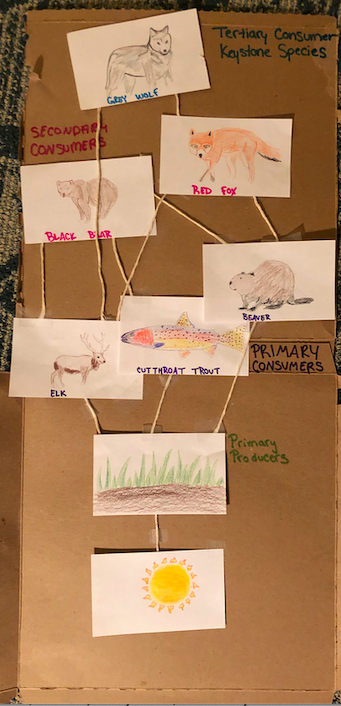Welcome to Change is Simple’s Online Learning Platform!
Overview: Today we are going to explore the ways in which plants and animals are connected through learning about food chains and food webs! Your student will have the opportunity to create a food web and learn about the impact different keystone species have on an entire ecosystem.
Grade Level: 3-5. For older grades, check out Activity 2.
Theme: Earth Systems
Supervision needed? No
Essential Questions:
Materials Needed:
Paper
Colored pencils, markers, or crayons
Tape
Cardboard
String
Standards:
Ecological Health 13.2 Describe how business, industry, and individuals can work cooperatively to solve ecological health problems, such as conserving natural resources and decreasing pollution
Ecological Health 13.4 Identify individual and community responsibility in ecological health.
Ecological Health 14.2 Identify ways the physical environment is related to individual and community health
Check out the video below to get started!
Vocabulary
Photosynthesis: The process by which green plants and some other organisms use sunlight to synthesize foods from carbon dioxide and water.
Primary Producer: an autotroph organism producing complex organic matter, using photosynthesis.
Primary Consumer: an organism that feeds on primary producers.
Secondary Consumer: an organism that feeds on primary consumers.
Tertiary Consumer: an organism that feeds on primary and secondary consumers.
Apex Predator: a predator that exists at the very top of the food chain.
Keystone Species: a species on which other species in an ecosystem largely depend, such that if it were removed the ecosystem would change drastically.
Activity 1: Create your food chain.
Now that you have an understanding of the producers and consumers that make up a food chain, let’s try our hand at making an entire food web!
Materials
Paper
Colored pencils, markers, or crayons
Tape
Cardboard
String
Step 1: Choose your favorite ecosystem.
An ecosystem is a community of living organisms (ex: plants and animals) and nonliving components (ex: water, and soil) In my video, I showed you a rainforest food chain. However, there are many others: Desert, ocean, tundra, grasslands are just a few! For this activity, I’m going to focus on Yellowstone National Park, which is a boreal forest!
Step 2: Draw the primary source of energy in your ecosystem. (Hint, it’s the same one that was in my video!)
Step 3: Draw 1-3 plants you may find in your ecosystem.
Can you recall from the video what we call plants in a food web?
Step 4: Draw 3 animals that eat the plants you have chosen.
Can you remember what we call organisms that eat our plants/primary producers?
Step 5: Draw 2 animals that eat the animals you just drew!
Can you remember what we call animals that eat our primary consumers?
Step 6: Draw the animal(s) that eat the animals you just drew!
Can you remember what we call the animals that eat our secondary consumers?
Step 7: Cut out all of your plants and animals. place the cut outs On your board.
Step 8: Create your food web! use markers or string to draw connections between the animals. Most animals eat more than one other species, so be sure to represent that!
Be sure to label your plants and animals by the primary producer, primary consumer, secondary consumer, tertiary consumer, and apex predator.
Additional Activity
For older students or for those interested in learning about the impacts of reintroducing a keystone species into the wild, check out this video on the grey wolf in Yellowstone National Park!
Read and Respond Activity
Read the following summary of an article written about the impact reintroducing grey wolves in yellowstone had on the ecosystem.
The Reintroduction of the Grey Wolf
“Wolves are causing a trophic cascade of ecological change, including helping to increase beaver populations and bring back aspen, and vegetation.” (Farquhar 2019).
In the 1930’s the grey wolf was poached to extinction in Yellowstone National Park. The absence of the wolf meant elk had fewer predators, and as a result elk population skyrocketed. This caused a chain reaction. The elk pushed the ecosystem to its carrying capacity by staying sedentary and heavily consuming willows, cottonwood, and aspen. Willow, being a crucial food source for the beaver along the rivers, declined in population. The decline in willow population led to a decline in beaver population. As beavers manage the riverbanks of Yellowstone, the rivers began to signs of deterioration, which affected birds, fish, and hunting grounds for bears.
Now that wolves have been reintroduced in Yellowstone, elk populations are stable, yet the elk are forced to move much more frequently so the pressure on willows has diminished, allowing beaver population to increase and the rivers to change once again. This story is an incredible example that highlights the power of a keystone species- and the damaging ways humans can impact an entire ecosystem.
Respond to the following questions.
Why do you think wolves were hunted to extinction in the 1930’s?
What do you think the long term impacts of wolf reintroduction will be?
Can you think of any animals that may be a keystone species? Are they endangered? If so, what can YOU do to help protect that species?
Reflection Questions
Give an example of a primary consumer and an example of a secondary consumer.
What is one thing you learned from this activity?
Why is it important to protect animals from becoming endangered or extinct?
What can YOU do to protect animals from becoming endangered or extinct?
Did you enjoy today’s activity? Stay tuned for more, and in the meantime…
Send us a photo of yourself doing today's activity and if you would like, please share your name(s) and where you are from with cisonline@changeissimple.org!







